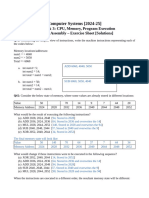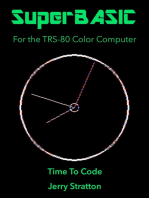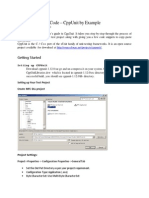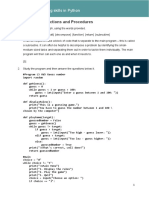Pseudo-Instructions: Assembler Psedudo-Instruction
Pseudo-Instructions: Assembler Psedudo-Instruction
Uploaded by
Yen BinhCopyright:
Available Formats
Pseudo-Instructions: Assembler Psedudo-Instruction
Pseudo-Instructions: Assembler Psedudo-Instruction
Uploaded by
Yen BinhOriginal Title
Copyright
Available Formats
Share this document
Did you find this document useful?
Is this content inappropriate?
Copyright:
Available Formats
Pseudo-Instructions: Assembler Psedudo-Instruction
Pseudo-Instructions: Assembler Psedudo-Instruction
Uploaded by
Yen BinhCopyright:
Available Formats
Pseudo-instructions
These are simple assembly language instructions that do not have a direct machine language equivalent. During assembly, the assembler translates each psedudoinstruction into one or more machine language instructions.
Example move $t0, $t1 # $t0 ! $t1
The assembler will translate it to add $t0, $zer0, $t1 We will see more of these soon.
slt $t0, $s0, $s1 bne $t0, $zero, label
# if $s0 < $s1 then $t0 =1 else $t0 = 0 # if $t0 " 0 then goto label
Pseudo-instructions give MIPS a richer set of assembly language instructions.
Loading a 32-bit constant into a register
Quite often, we would like to load a constant value into a register (or a memory location)
lui $s0, 42
# load upper-half immediate
ori $s0, $s0, 18 # (one can also use andi)
What is the end result?
Compiling a switch statement
switch (k) { case 0: case 1: case 2: case 3: } f = i + j; break; f = g + h; break; f = g h; break; f = i j; break;
New instruction
slt $s1, $s2, $s3
(set less than)
(if $s2 < $s3 then set $s1 to 1)
Assume, $s0-$s5 contain f, g, h, i, j, k. Let $t2 contain 4.
slt $t3, $s5, $zero bne $t3, $zero, Exit slt $t3, $s5, $t2 beq $t3, $zero, Exit
# if k < 0 then $t3 = 1 else $t3=0 # if k<0 then Exit # if k<4 then $t3 = 1 else $t3=0 # if k# 4 the Exit
What next? Jump to the right case!
32-bit address L0 32-bit address L1 32-bit address L2 32-bit address L3
Base address of the jumptable
jumptable register $t4
L0
f=i+j J Exit
L1
f = g+h j Exit
Exit
MEMORY
Here is the remainder of the program;
add $t1, $s5, $s5 add $t1, $t1, $t1 add $t1, $t1, $t4 lw $t0, 0($t1) jr $t0 L0: add $s0, $s3, $s4 J Exit L1: add $s0, $s1, $s2 J Exit L2: sub $s0, $s1, $s2 J Exit L3: sub $s0, $s3, $s4 Exit: <next instruction>
# t1 = 2*k # t1 = 4*k # t1 = base address + 4*k # load the address pointed # by t1 into register t0 # jump to addr pointed by t0 #f=i+j
# f = g+h
# f = g-h
#f=i-j
The instruction formats for jump and branch
10000
is represented as
2500
6-bits
26 bits
This is the J-type format of MIPS instructions.
Conditional branch is represented using I-type format:
bne $s0, $s1, Label
is represented as
16
17
16-bit offset
Current PC + (4 * offset) determines the branch target Label
This is called PC-relative addressing.
Revisiting machine language of MIPS
# starts from 80000 Loop: add $t1, $s3, $s3 add $t1, $t1, $t1 add $t1, $t1, $s6 lw $t0, 0($t1)
What does this program do?
bne $t0, $s5, Exit add $s3, $s3, $s4 j Exit: 6 80000 80004 80008 80012 80016 80020 80024 80028 0 0 0 35 5 0 2 5 19 9 9 9 8 19 5 19 9 22 8 21 20 19 5 9 9 9 5 0 0 0 0 2 (why?) 0 32 6 32 32 32 Loop
Machine language version
R-type R-type R-type I-type I-type R-type J-type
20000 (why?)
Addressing Modes
What are the different ways to access an operand?
Register addressing Operand is in register add $s1, $s2, $s3 means $s1 ! $s2 + $s3
Base addressing Operand is in memory. The address is the sum of a register and a constant. lw $s1, 32($s3) means $s1 ! M[s3 + 32]
As special cases, you can implement
Direct addressing
$s1 ! M[32]
Indirect addressing
$s1 ! M[s3]
Which helps implement pointers.
Immediate addressing The operand is a constant. How can you execute $s1 ! 7?
addi $s1, $zero, 7 means $s1 ! 0 + 7 (add immediate, uses the I-type format)
PC-relative addressing The operand address = PC + an offset Implements position-independent codes. A small offset is adequate for short loops.
Pseudo-direct addressing Used in the J format. The target address is the concatenation of the 4 MSBs of the PC with the 28-bit offset. This is a minor variation of the PC-relative addressing format.
You might also like
- Compiling A Switch StatementDocument9 pagesCompiling A Switch StatementAli Sa'eidNo ratings yet
- Using AND For Bit Manipulation: 6 5 5 16 8 16 10 1 Andi s0 t2Document7 pagesUsing AND For Bit Manipulation: 6 5 5 16 8 16 10 1 Andi s0 t2doomachaleyNo ratings yet
- Mips IsaDocument32 pagesMips Isasivakumarb92No ratings yet
- Instruction FormatDocument29 pagesInstruction FormatDada ArlongNo ratings yet
- Computer Organization Homework 2: Our Answer atDocument5 pagesComputer Organization Homework 2: Our Answer atLe ngo thiNo ratings yet
- Instruction Set Architecture: Mips Section 2.6-2.7,2.8,2.9Document26 pagesInstruction Set Architecture: Mips Section 2.6-2.7,2.8,2.9api-26072581No ratings yet
- Lecture 10 - CH 02Document17 pagesLecture 10 - CH 02Osama RousanNo ratings yet
- 4 Decision Instructions NewDocument19 pages4 Decision Instructions NewZagim Murtza AwanNo ratings yet
- Chap3 MIPS Part2Document23 pagesChap3 MIPS Part2phamngocphu17012004No ratings yet
- 4 Decision Instructions New 2Document19 pages4 Decision Instructions New 2Zagim Murtza AwanNo ratings yet
- Tutorial # 2 SolutionDocument3 pagesTutorial # 2 SolutionpastosNo ratings yet
- CSCI-365 Computer OrganizationDocument18 pagesCSCI-365 Computer OrganizationSebastianAlbertoRodriguezNo ratings yet
- Lecture 5Document31 pagesLecture 5rishi prasadNo ratings yet
- Today's Topics: Procedures More Examples MARS Intro Number SystemsDocument43 pagesToday's Topics: Procedures More Examples MARS Intro Number SystemsUlas GulerNo ratings yet
- Math Full ProveDocument30 pagesMath Full ProveNm Nazmul HoqueNo ratings yet
- Decision Instructions: CS353 - Computer ArchitectureDocument43 pagesDecision Instructions: CS353 - Computer Architectureمحمد اویسNo ratings yet
- Various Branch InstructionsDocument8 pagesVarious Branch InstructionsdoomachaleyNo ratings yet
- CSE 420 Fall 2018 Module 1 Sample QuestiDocument18 pagesCSE 420 Fall 2018 Module 1 Sample QuestiNivedita Acharyya 2035No ratings yet
- Csci 260 Study Guide-4Document10 pagesCsci 260 Study Guide-4zubayerthewizardNo ratings yet
- Branches and Procedure Calls: Harris & Harris Morgan Kaufmann / Elsevier, 2007Document21 pagesBranches and Procedure Calls: Harris & Harris Morgan Kaufmann / Elsevier, 2007David VelasquezNo ratings yet
- CA ch2Document14 pagesCA ch2Llazi LegjendaNo ratings yet
- Lecture 2: MIPS Instruction SetDocument24 pagesLecture 2: MIPS Instruction Settratgiakiet2008No ratings yet
- Lecture 04 - Instruction Encoding IIDocument18 pagesLecture 04 - Instruction Encoding IIOmar AhmedNo ratings yet
- CSE 3666 Homework 2Document7 pagesCSE 3666 Homework 2Patricia AlfonsoNo ratings yet
- Going From C To MIPS: Spring 2007 CS61c Week 4 Discussion NotesDocument6 pagesGoing From C To MIPS: Spring 2007 CS61c Week 4 Discussion NotesAvi GabayNo ratings yet
- AM - EN.U4CSE20148 COA Lab Sheet 4Document13 pagesAM - EN.U4CSE20148 COA Lab Sheet 4Arjun ReddyNo ratings yet
- hw1 SolnDocument2 pageshw1 SolnBin Phan VanNo ratings yet
- ELEN 468 Advanced Logic Design: MIPS MicroprocessorDocument19 pagesELEN 468 Advanced Logic Design: MIPS MicroprocessorMahendranath CholletiNo ratings yet
- For More PracticeDocument6 pagesFor More PracticeMarwan SamiNo ratings yet
- 04 TE Arsikom2Document20 pages04 TE Arsikom2FSArifNo ratings yet
- Mi Ps DetailsDocument124 pagesMi Ps DetailsMilind ShahNo ratings yet
- Instruction Set Architecture-Nguyễn Hoàng Long - BI11-157Document11 pagesInstruction Set Architecture-Nguyễn Hoàng Long - BI11-157Long NguyễnNo ratings yet
- Midterm Solutions (1 of 3) Assembly Language EEE 230Document3 pagesMidterm Solutions (1 of 3) Assembly Language EEE 230Bryon MitchellNo ratings yet
- Chapter 2 Solutions: For More PracticeDocument8 pagesChapter 2 Solutions: For More Practicekamalpreet_gNo ratings yet
- 03 - CPU Memory Program Execution Assembly - Exercise Sheet (Solutions) - 1504219614Document6 pages03 - CPU Memory Program Execution Assembly - Exercise Sheet (Solutions) - 1504219614adithyaa sudhakarNo ratings yet
- CA Lec4 Chap2 MIPS Instructions 3Document38 pagesCA Lec4 Chap2 MIPS Instructions 3manalNo ratings yet
- Coa Slide 1 PDFDocument24 pagesCoa Slide 1 PDFTuli DeviNo ratings yet
- CNE302 - Lec 3 - MIPS (Logic - Memory - Control Flow)Document16 pagesCNE302 - Lec 3 - MIPS (Logic - Memory - Control Flow)manarkhaliidxNo ratings yet
- CMP 18Document46 pagesCMP 18ovmlcabreraNo ratings yet
- Chapter 2Document58 pagesChapter 2SomaticQiNo ratings yet
- ECE 445 - Fall 2020 - Lecture 5 - Programming in Assembly LanguageDocument45 pagesECE 445 - Fall 2020 - Lecture 5 - Programming in Assembly Language陳柏鈞No ratings yet
- لاب 3.1 +3.2 1Document12 pagesلاب 3.1 +3.2 1vip14No ratings yet
- Mips TutorialDocument44 pagesMips TutorialIoana MarussiNo ratings yet
- MIPS Intro / Decisions: CS270 Unit 3 Max Luttrell, Spring 2017Document47 pagesMIPS Intro / Decisions: CS270 Unit 3 Max Luttrell, Spring 2017kNo ratings yet
- Mips Programming (2) : Assembly LanguageDocument28 pagesMips Programming (2) : Assembly LanguageJavier ParragaNo ratings yet
- Assignment 3: 1. Given The MIPS Assembly CodeDocument12 pagesAssignment 3: 1. Given The MIPS Assembly CodePhan TanNo ratings yet
- College of Computer Science: Chapter 2: Instruction Set Architecture (ISA) : Instruction Formats & MIPS InstructionsDocument25 pagesCollege of Computer Science: Chapter 2: Instruction Set Architecture (ISA) : Instruction Formats & MIPS Instructionsعبدالآله الشريفNo ratings yet
- ITCS 321 Test ONE NOV 2018 KEY AAADocument5 pagesITCS 321 Test ONE NOV 2018 KEY AAAt69mdtd6z7No ratings yet
- Csci 260 Study Guide-5Document10 pagesCsci 260 Study Guide-5zubayerthewizardNo ratings yet
- MIPS Instruction Reference: NPC To PCDocument9 pagesMIPS Instruction Reference: NPC To PCVõ Quy QuangNo ratings yet
- CA ch2 PDFDocument14 pagesCA ch2 PDFdeepak kumarNo ratings yet
- 03-Instruction Set ArchitectureDocument40 pages03-Instruction Set ArchitectureccoccoheadNo ratings yet
- Misp Procedure CallsDocument34 pagesMisp Procedure CallsFernando GonzalezNo ratings yet
- 2 Isa cs161f16Document109 pages2 Isa cs161f16Van Thi Muoi Ngoc NgocNo ratings yet
- MIPS Practice Questions - ANSWERSDocument5 pagesMIPS Practice Questions - ANSWERSRajeen VenuraNo ratings yet
- Redacted ResumeDocument1 pageRedacted ResumeAnonymous 07bX5XWnNo ratings yet
- A Survey of Software Development Process Models in Software EngineeringDocument11 pagesA Survey of Software Development Process Models in Software Engineeringاحمد رياض عبداللهNo ratings yet
- Unit 3 Notes of Dot Net Unit 3Document30 pagesUnit 3 Notes of Dot Net Unit 3RX GamerNo ratings yet
- Programmer Resume ExamplesDocument7 pagesProgrammer Resume Examplesqwaskmrmd100% (1)
- Interview Questions PL SQLDocument5 pagesInterview Questions PL SQLNaveen LazarusNo ratings yet
- Mobile Application DevelopmentDocument3 pagesMobile Application DevelopmentLucky Man TharunNo ratings yet
- Presentation Title: Debugging Simulation ModelsDocument74 pagesPresentation Title: Debugging Simulation ModelsflyingdreamsNo ratings yet
- Abdullah Sap-Bw Bobj - BiDocument6 pagesAbdullah Sap-Bw Bobj - BiHARSHANo ratings yet
- Python Course Slides - PPTX - AutoRecoveredDocument53 pagesPython Course Slides - PPTX - AutoRecoveredMy Life StyleNo ratings yet
- Lab 8Document16 pagesLab 8sameen arshadNo ratings yet
- Unit Testing C++ Code - CppUnit by ExampleDocument11 pagesUnit Testing C++ Code - CppUnit by ExamplesreejithmadamanaNo ratings yet
- String: Etl Labs PVT LTD - Java ProgrammingDocument26 pagesString: Etl Labs PVT LTD - Java ProgrammingETL LABSNo ratings yet
- Linked Lists Lecture NotesDocument12 pagesLinked Lists Lecture NotesJamilu AlhassanNo ratings yet
- 2 Pass AssemblerDocument23 pages2 Pass Assemblerprashanthreddyburri100% (1)
- Miguel O.Python Skills Homework 3Document2 pagesMiguel O.Python Skills Homework 3Miguel Oubiña SánchezNo ratings yet
- Hacking Experiment Using USB Rubber Ducky ScriptingDocument6 pagesHacking Experiment Using USB Rubber Ducky ScriptingJozef HakalaNo ratings yet
- PDF CV ErmanDocument6 pagesPDF CV ErmanAnonymous DZIFwUBYNo ratings yet
- Siva ResumeDocument6 pagesSiva Resumeapi-218229532No ratings yet
- Module 3 CPU Process SchedulingDocument4 pagesModule 3 CPU Process SchedulingMc John PobleteNo ratings yet
- Redux Cheat SheetDocument1 pageRedux Cheat SheetVikram BhaskaranNo ratings yet
- HTML FormattingDocument21 pagesHTML Formattingk1rit0No ratings yet
- Vnxe Service CommandsDocument69 pagesVnxe Service CommandsJesusMendozaPachasNo ratings yet
- Quick Start GuideDocument2 pagesQuick Start GuideEDWIN ROBERTO MOLIAN RAMIREZNo ratings yet
- Jasmin Instruction SyntaxDocument6 pagesJasmin Instruction SyntaxĐỗ Lê Minh HiểnNo ratings yet
- ServiceDocument10 pagesServiceMahdi AkhmadNo ratings yet
- Jython 2Document100 pagesJython 2Umapathi BaskarNo ratings yet
- Armadillo OEP Finder + Fix Magic Jumps + Fix Anti-DumpDocument3 pagesArmadillo OEP Finder + Fix Magic Jumps + Fix Anti-Dumpjaiswalnilesh5132No ratings yet
- Unit 22 People in Computing Model AnswersDocument9 pagesUnit 22 People in Computing Model AnswerspaczekNo ratings yet
- Pi - Ygw - 1.8.0.1 3Document97 pagesPi - Ygw - 1.8.0.1 3Arsa Arka GutomoNo ratings yet
- ArchiCAD 16 - Help Center - ArchiCAD, BIMx, BIM Server Knowledge Base From GRAPHISOFTDocument19 pagesArchiCAD 16 - Help Center - ArchiCAD, BIMx, BIM Server Knowledge Base From GRAPHISOFTGabriel KarikasNo ratings yet

























































































